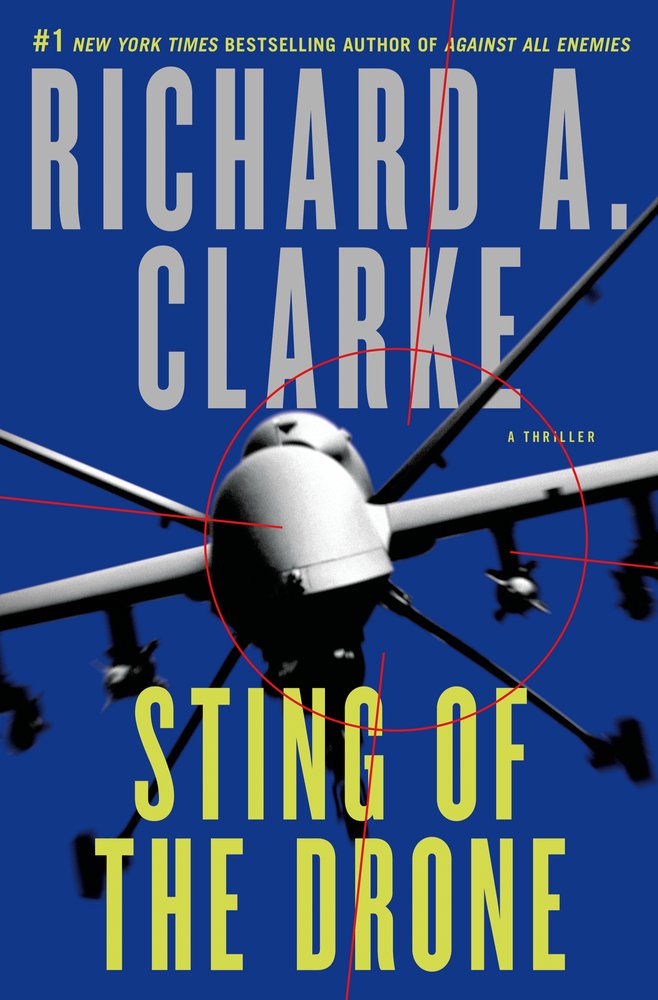By: Terresa Monroe-Hamilton

Purchase at Amazon.com
I have always had serious misgivings concerning the drone program. It’s an excellent weapon to take out the enemy… and a deadly kill shot that can be used against Americans. It all depends on who controls the controllers. Having said that, I just read a fascinating book from Richard A. Clarke on Unmanned Aerial Vehicles and a war waged from both perspectives in a fast-paced thriller that gives a glance into the drone program. You get to theorize and imagine drone wars up close and personal. You also get to read what it would be like if the enemy could really slap us back as a nation. Enter Richard A. Clarke’s new thriller: Sting of the Drone.
In the clandestine and violent world of espionage and international war games, a chilling potential for kill lists has arisen. Within 10 years, every country on the planet will have drones. The world is about to become a lot more dangerous instead of safer with the capability to kill remotely, silently, instantly. It will also be a hacker’s dream come true and a terrorists candy shop as the technology falls into the hands of those who have darker agendas.
I have not always agreed with Mr. Clarke politically, but he is a gifted writer and he knows the Intel community and is ringing the alarms on cyber war:
Richard A. Clarke served for thirty years in the United States Government, including an unprecedented ten continuous years as a White House official, serving three consecutive Presidents. In the White House he was Special Assistant to the President for Global Affairs, Special Advisor to the President for Cyberspace, and National Coordinator for Security and Counter-terrorism.
Prior to his White House years, he served as a diplomat, including as Assistant Secretary of State and held other positions in the State Department and the Pentagon.
Since leaving government in 2003, Mr. Clarke has served as an on-air consultant for ABC News for ten years, taught at Harvard’s Kennedy School of Government for five years, managed a consulting firm, chaired the Board of Governors of the Middle East Institute, and written six books, both fiction and non-fiction, including the national number one bestseller Against All Enemies and Cyber War: The Next Threat to National Security and What to Do About It.
The book points out how political the selection of targets is and how the whim of a bureaucrat or a politician can spell death for friend or foe, depending on the perspective. I agree, we have many enemies that should be eliminated with prejudice. What concerns me is the ethical line that is drawn or not, as the case may be. Once a politician gets a taste of playing God and deciding who lives or dies, it’s like trying to wean someone off heroin. Not likely.
In Washington, the Kill Committee gathers in the White House’s Situation Room to pick the next targets for the United States drone program. At an airbase just outside Las Vegas, a team of pilots, military personnel and intelligence officers follow through on the committee’s orders, finding the men who have been deemed a threat to national security and sentenced to death.
On the other side of the world, in the mountains where the drones hunt their prey, someone has decided to fight back. And not just against the unmanned planes that circle their skies, but against the Americans at home who control them.
Clarke not only remains an active and respected presence within the national security community but also appears regularly as an expert commentator for ABC and other media. His insider’s expertise is on full display in Sting of the Drone, a breathtakingly realistic novel set within America’s contentious drone program.
About Drones from Clarke’s website:
Readers of two of my earlier books may recall that I have some personal responsibility for the use of drones against terrorists. In full disclosure, here is that story. I served in the White House for over a decade beginning in 1992, for three consecutive Presidents. My job for many of those years was National Coordinator for Security and Counter-terrorism. In that capacity, I came to believe that we needed to capture or kill the leadership of a group few people in the United States had ever heard of, al Qaeda.
The CIA was instructed to get bin Laden, but proved incapable of doing so. They were then asked to locate him reliably in a place where he could be staying for at least four hours, so that we could launch cruise missiles at the site. That did not work either. Frustrated, I asked for an independent review by Charlie Allen, a legendary intelligence officer and iconoclast. Charlie suggested we deploy predators to the region and fly them over Afghanistan. Predators were only available as unarmed aircraft in those days, but we thought that they might be better than past efforts to find bin Laden. CIA and the Pentagon, however, opposed the use of Predator for this purpose.
Eventually, the White House had to order the CIA to do a test deployment of the unarmed Predators. I still recall my amazement, sitting in a darkened room well after midnight Washington time, watching live video feed from Afghanistan, following a truck, zooming in on a camp. On the fourth flight, bin Laden was located. Then the winter set in and the winds were such that we could not fly the Predator over the mountains into Afghanistan from its base in Central Asia. We would not be able to fly again until spring. It was the fall of 2000 and the Clinton administration was coming to a close.
During the winter, I tried to get the Air Force to arm the Predator with missiles. They had thought about it, but had no plans to try it for several years. With the help of USAF General John Jumper, we compressed that timeline into a few months. Predator, armed with Hellfire missiles, worked well in experimental flights. We then sought approval from the new Bush administration to deploy this armed Predator to get bin Laden. Once again, the CIA and the Pentagon opposed the mission. I pressed for a decision to override them again, but National Security Advisor Condoleezza Rice delayed a decision for months.
Finally, on September 4, 2001, CIA proposed deploying armed Predators to attack al Qaeda in Afghanistan. On November 12, 2001, in Afghanistan, Mohammed Atef, the head of al Qaeda’s military forces, became the first person killed by a Predator. Since then the United States has killed at least two thousand people in five countries using armed drones. And the killing continues.
The book is a great read. But the implementation of drones is a bit like opening Pandora’s box and can never be undone. Death from the skies is now a way of life, but what if the enemy turns the tables? Find out and get Sting of the Drone.
















